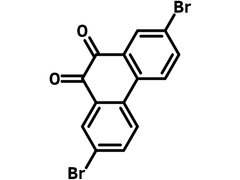2,7-Dibromophenanthrene-9,10-dione
CAS Number 84405-44-7
Chemistry Building Blocks, Dibromo Monomers, Materials, Monomers, Non-Heterocyclic Building Blocks2,7-Dibromophenanthrene-9,10-dione
Very useful intermediate for the synthesis of semiconducting small molecule, oligomers and polymers in applications of OFETs, OLEDs and OPVs.
Specifications | MSDS | Literature and Reviews
2,7-Dibromophenanthrene-9,10-dione (CAS number 84405-44-7), one of the isomers of 2,6-dibromoanthraquinone, can be considered as a 4,4'-dibromobiphenyl bridged by 1,2-diketones. Bromo-function groups at 2,7-postions gives rise to further C-C formation reactions to extend conjugation to its core structure while diketone can form quinoxalines via condensation with diamines. 2,7-Dibromophenanthrene-9,10-dione is very useful intermediate for the synthesis of semiconducting small molecule, oligomers and polymers in applications of OFETs, OLEDs and OPVs.
Pure organic based phosphorescent light-emitting diodes based on 2,7-dibromophenanthrene-9,10-dione as an emitter and bromine modified 6,11-dibromodibenzo[f,h]quinoxaline as a host showed phosphorescent emission with an external quantum efficiency of 0.11%. OLED device based on DQBC with a dibenzo[a,c]phenazine core achieves maximum external quantum efficiency of 39.1% without any external light-extraction techniques, together with a maximum power efficiency of 112.0 lm W-1 and alleviated efficiency roll-off.
Phenanthrenedione building block
for the synthesis of COFs, OLED and organic photovoltaic materials
Worldwide shipping
Quick and reliable shipping
Capped with bromides
for facile coupling reactions
High purity
>97% Purity
General Information
| CAS Number | 84405-44-7 |
| Chemical Formula | C14H6Br2O2 |
| Full Name | 2,7-Dibromophenanthrene-9,10-dione |
| Molecular Weight | 366.01 g/mol |
| Synonyms | 2,7-Dibromo-9,10-phenanthrenedione, 27PNDO |
| HOMO/LUMO | HOMO = 6.99 eV, LUMO = 4.44 eV |
| Classification / Family | Phenanthrene, semiconductor synthesis intermediates, low band gap polymers, OLED, OFETs, organic photovoltaics |
Chemical Structure

Product Details
| Purity | >97% (1H NMR in CDCl3) |
| Melting Point | Tm = 274.3 °C |
| Appearance | Orange to red powder/crystals |
MSDS Documentation
 2,7-Dibromophenanthrene-9,10-dione MSDS Sheet
2,7-Dibromophenanthrene-9,10-dione MSDS Sheet
Literature and Reviews
-
T and V-shaped donor-acceptor fluorophores involving pyridoquinoxaline: large Stokes shift, environment-sensitive tunable emission and temperature-induced fluorochromism, B. Sk et al., Chem. Commun., 54, 1786-1789 (2018); DOI: 10.1039/C7CC09261J.
-
Structure-property relationship of D-A type copolymers based on phenanthrene and naphthalene units for organic electronics, Y. Kim et al., J. Mater. Chem. C, 5, 10332-10342 (2017); DOI: 10.1039/C7TC02925J.
-
The Extension of Conjugated System in Pyridyl-Substituted Monoazatriphenylenes for the Tuning of Photophysical Properties, D. Kopchuk et al., Chem. Heterocycl. Comp. 50, 871–879 (2014); DOI: 10.1007/s10593-014-1541-0.
